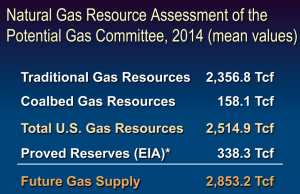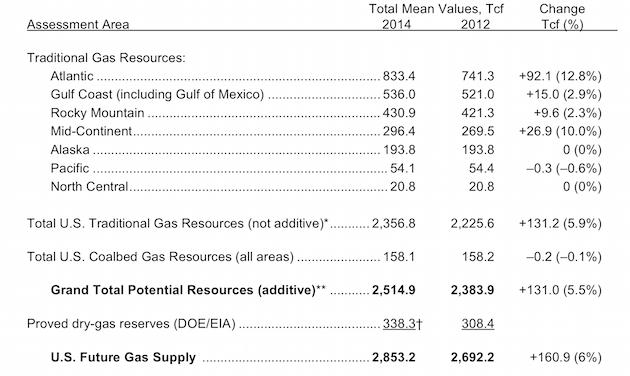“An exceptionally strong and optimistic gas supply picture for the nation”
After two years of number crunching by 100 volunteer geoscientists and petroleum engineers, the Potential Gas Committee (PGC) in Golden, Colorado, says the United States possesses a total technically recoverable resource base of 2,515 trillion cubic feet (Tcf) of natural gas, as of year-end 2014. This is the highest resource evaluation in the PGC’s 50-year history of putting out biennial assessments of the nation’s natural gas supply.
Toss in EIA proved reserves of 338 Tcf and the nation is sitting on top of a future gas supply of 2,853 Tcf.
The PGC’s 2,515 Tcf represents a 131 Tcf increase from its most recent assessment two years ago, arising primarily from reevaluations of shale gas resources in the Atlantic, Mid-Continent, Gulf Coast and Rocky Mountain areas, and conventional/tight gas resources in the Mid-Continent and Rockies, according to the PGC 50th anniversary report.
“The PGC’s year-end 2014 assessment reaffirms the committee’s conviction that abundant, recoverable natural gas resources exist within our borders, both onshore and offshore, and in all types of reservoirs—from conventional, ‘tight’ and shales, to coals,” said Dr. John B. Curtis, Director of the Potential Gas Agency at the Colorado School of Mines.
Shale revolution brings fast growth to PGC assessments
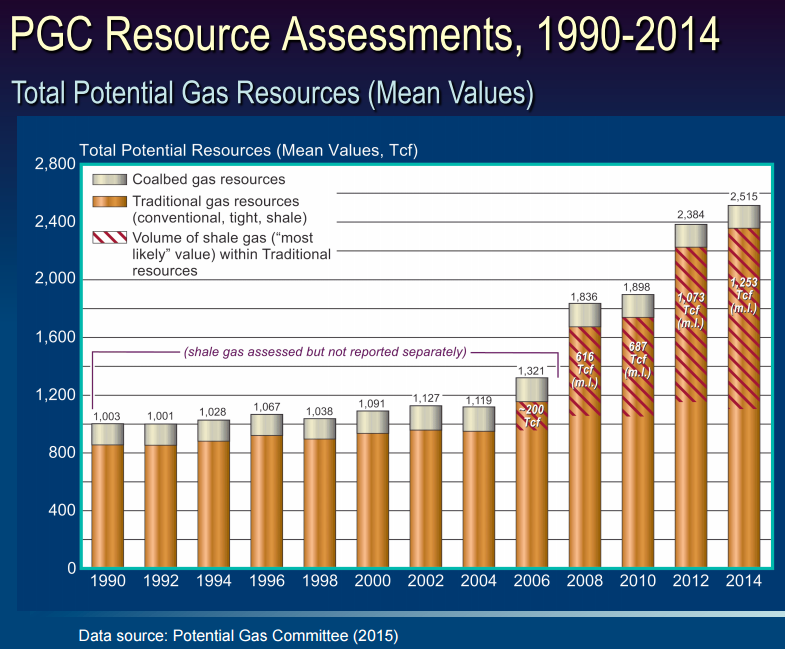 It is no surprise that the U.S. shale developers were primary drivers of growth in the Potential Gas Committee’s last few assessments of the nation’s natural gas resource. The 2006 report assessed shale volume at approximately 200 Tcf. By 2014 shale was responsible for 1,253 Tcf–about half of the overall natural gas resource in the U.S.
It is no surprise that the U.S. shale developers were primary drivers of growth in the Potential Gas Committee’s last few assessments of the nation’s natural gas resource. The 2006 report assessed shale volume at approximately 200 Tcf. By 2014 shale was responsible for 1,253 Tcf–about half of the overall natural gas resource in the U.S.
The Potential Gas Committee’s year-end 2014 assessment of 2,515 Tcf includes:
-
2,357 Tcf of gas potentially recoverable from “Traditional” reservoirs (conventional, tight sands and carbonates, and shales)
-
158 Tcf in coalbed reservoirs
“Our knowledge of the geological endowment of technically recoverable gas continues to improve with each assessment,” Curtis said. “New and advanced exploration, well drilling, completion and stimulation technologies are allowing us increasingly better delineation of and access to domestic gas resources—especially ‘unconventional’ gas—which, not all that long ago, were considered impractical or uneconomical to pursue.”
How much natural gas does the U.S. consume?
According to the Department of Energy’s U.S. Energy Information Administration (EIA), in 2014, the United States consumed approximately 26.79 trillion cubic feet (Tcf) of natural gas.
Using the PGC figures, if extracted and sold, the 2,853 Tcf of future gas supply calculated in its latest report would supply U.S. domestic consumption for more than 100 years (assuming the 2014 usage rate remained flat for the next century).
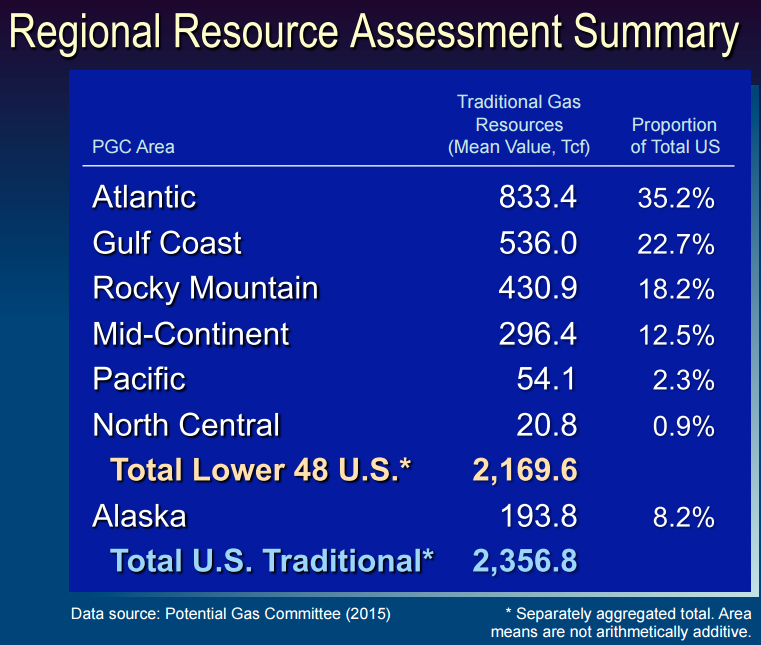 Appalachian basin shale gas leads the way
Appalachian basin shale gas leads the way
The report said that Appalachian basin’s shale gas makes the Atlantic area the country’s richest resource area with 35% of total U.S. Traditional resources, followed by the Gulf Coast (including the Gulf of Mexico) with 23%, Rocky Mountains with 18%, and the Mid-Continent with 12.5%.
The largest volumetric and percentage gains were reported for Appalachian shales, primarily the Marcellus but also including the Utica and the newly assessed Rogersville Shale, which collectively rose by 137 Tcf (24%).
Gulf Coast driven up by Eagle Ford wet gas and condensate, and the TMS
Gulf Coast assessments rose by 15 Tcf (3%), reflecting continued aggressive development of wet gas and condensate in the prolific Eagle Ford Shale of the Texas Gulf Coast basin and a first-time assessment for the Cretaceous Tuscaloosa marine shale in Louisiana.
Barnett Shale and Permian’s Bone Spring and Wolfcamp on the rise
For the Mid-Continent, modest declines in assessments for the Arkoma and Anadarko basins (conventional reservoirs and shales) were offset by substantially higher evaluations of the Barnett Shale in the Fort Worth basin and the stacked pays of the Bone Spring and Wolfcamp plays in the Permian basin. The area’s total assessment gained 26.9 Tcf (10%).
New data drive up Piceance and D-J gas resource
The 9.6-Tcf (2.3%) net increase for the Rocky Mountain area resulted from reevaluation of new data and drilling results from the Cretaceous Niobrara shale play in western Colorado’s Piceance basin and the Niobrara fractured-carbonate play in the Denver basin.
The growing importance of shale gas nationwide is substantiated by the fact that the PGC’s total assessed shale gas resource of 1,253 Tcf for 2014 accounts for approximately 61% of the country’s total Traditional potential resources, up from 57 percent in 2012.
Details of the Potential Gas Committee’s Natural Gas Resource Assessment
The Potential Gas Committee (PGC) reports its biennial potential gas resource assessments in three categories of decreasing geological certainty—Probable, Possible and Speculative. The PGC’s assessments are not static. Based on new exploration results, drilling and production information and various other data that become available, PGC members may reclassify resources at the province level from one category to another and to proved reserves.
* Mean values for Probable, Possible and Speculative resources are not arithmetically additive in deriving Total Traditional Gas Resources and Total Coalbed Gas Resources.
** The separately aggregated mean values for Total Traditional Resources and Total Coalbed Gas Resources are arithmetically additive in deriving Grand Total Potential Resources.
† Latest available figure is for year-end 2013.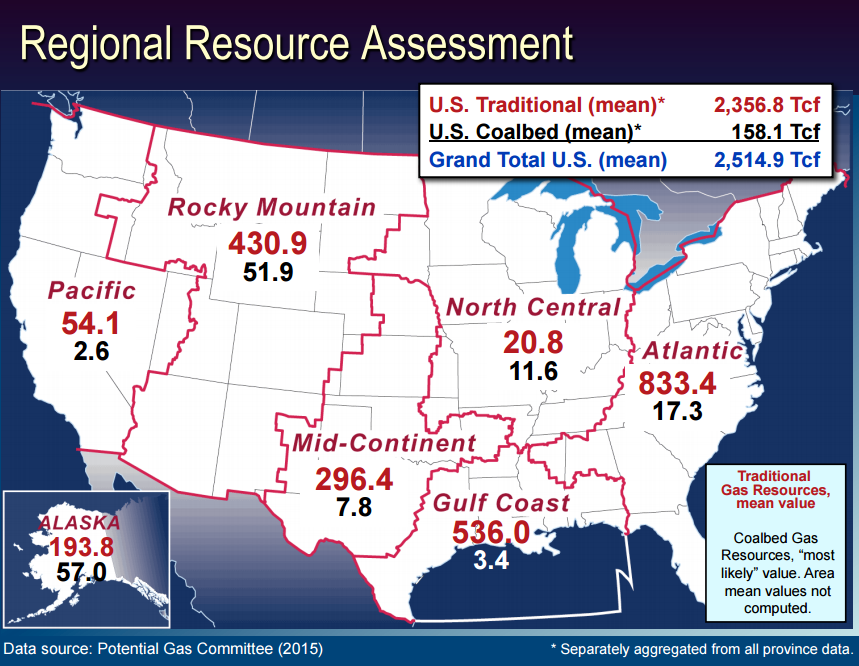
PGC’s 90 geological provinces are grouped into seven geographic assessment areas:
* Mean values of Traditional Resources for the seven areas are not arithmetically additive in deriving Total U.S. Traditional Resources, which is a separately aggregated value. Area-level changes in values from 2012 to 2014 likewise are not arithmetically additive in deriving the total change.
** The separately aggregated mean values for Total U.S. Traditional Gas Resources and Coalbed Gas Resources are arithmetically additive in deriving Grand Total Potential Resources.
† Latest available figure is for year-end 2013.
Note: the Potential Gas Agency at the Colorado School of Mines provides the Potential Gas Committee with guidance, technical assistance, training and administrative support, and assists in member recruitment and outreach. The Potential Gas Agency receives financial support from prominent E&P companies, gas pipeline companies and distributors, and individuals.
Orders for the PGC’s 124-page 50th Anniversary report, Potential Supply of Natural Gas in the United States (December 31, 2014), may be placed with the Potential Gas Agency, Colorado School of Mines, Golden, CO 80401-1887. The cost of the printed report book is US $325 plus shipping.

